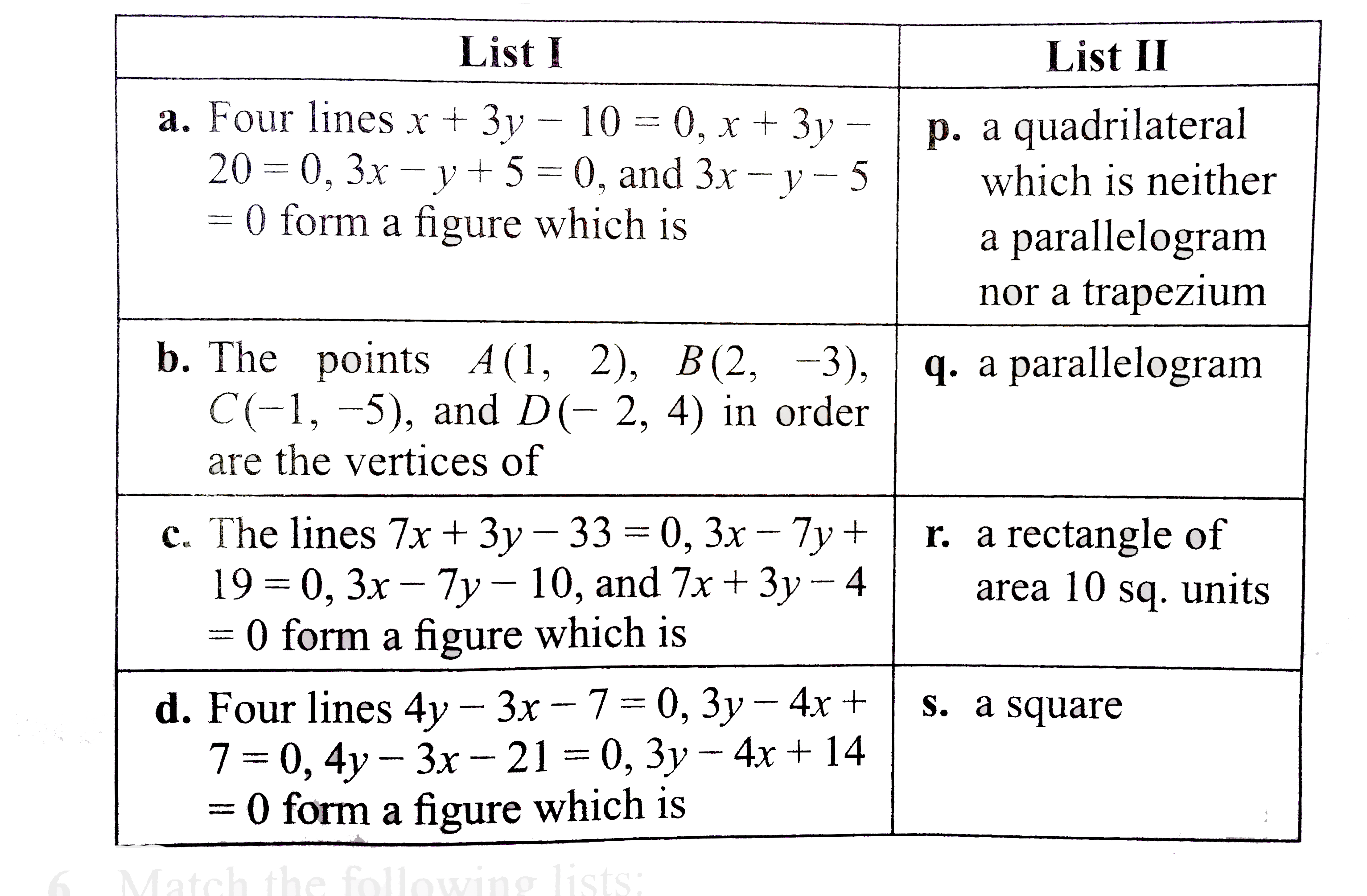The equation of an altitude of an equilateral triangle is √3x+y=2√3, and one of the vertices is (3,√3).
Which of the following is not one of the possible vertices of the triangle?Solution in Bengali
a.√3
b.√3
c. 2
d. none of these
The correct Answer is:A

Let the triangle be ABC with C≡(3,√3) and the altitude drawn through the vertex (meeting BC at D) be √3x+y−2√3=0.If Bis(xb,yb),
then we have
xb−3√3=yb−√31=2(3√3+√3−2√3)4=−√3
or xb=0,yb=0
and the coordinates of D are (3/2,√3/2). Let the coordinates of vertex A be (xa,ya). Then,
xa−(3/2)−1/2=ya−(√3/2)√3/2=±3
or(xa,ya)≡(0,2√3) or (3,−√3)
Hence, the remaining vertices are (0,0) and (0,2√3) or (0,0) and (3,−√3). Also, the orthocenter is (1,√3) or (2,0).
Topper's Solved these Questions
- BOOK - CENGAGE PUBLICATIONCHAPTER - STRAIGHT LINESEXERCISE - EXERCISE (MATRIX MATCH TYPE)8videos
STRAIGHT LINES
- BOOK - CENGAGE PUBLICATIONCHAPTER - STRAIGHT LINESEXERCISE - EXERCISE (NUMERICAL VALUE TYPE)13videos
STRAIGHT LINES
- BOOK - CENGAGE PUBLICATIONCHAPTER - STRAIGHT LINESEXERCISE - EXERCISE (MULTIPLE CORRECT ANSWERS TYPE)30videos
STRAIGHT LINES
- BOOK - CENGAGE PUBLICATIONCHAPTER - STRAIGHT LINEEXERCISE - Multiple Correct Answers Type8videos
STRAIGHT LINE
- BOOK - CENGAGE PUBLICATIONCHAPTER - THEORY OF EQUATIONSEXERCISE - JEE ADVANCED (Numerical Value Type )1videos
THEORY OF EQUATIONS
Similar Questions
Match the following lists:
 04:06View Solution
04:06View SolutionFind the number of permutations of the set {1,2,3,4} in which no two adjacent positions are filled by consecutive integers ( increasing orders).
04:49View SolutionIf P is a point (x,y) on the line y=−3x such that P and the point (3, 4) are on the opposite sides of the line 3x−4y=8, then x>815 (b) x>85 y<−85 (d) y<−815
03:51View SolutionThe point P(α,α+1) will lie inside the triangle whose vertices are A(0,3),B(−2,0) and C(6,1) if
03:08View SolutionThe number of distinct real roots of x4−4x3+12x2+x−1=0is_____.
02:14View SolutionLet A(6,7),B(2,3) and C(-2,1) be vertices of a triangle.The point P in the interior of Delta ABC such that Delta PBC is an equilateral triangle is (A)(-sqrt(3),2+2sqrt(3))(B)(-sqrt(3),2-2sqrt(3))(C)(sqrt(3),2-2sqrt(3))(D)(sqrt(3),2+2sqrt(3))
02:53View SolutionThe joint equation of two altitudes of an equilateral triangle is (sqrt(3)x-y+8-4sqrt(3))(-sqrt(3)x-y+12+4sqrt(3))=0 The third altitude has the equation
10:50View SolutionThe equation of an altitude of an equilateral triangle is sqrt(3)x+y=2sqrt(3) and one of its vertices is (3,sqrt(3)) then the possible number of triangles is
08:45View SolutionThe equation to the base of an equilateral triangle is (sqrt(3)+1)x+(sqrt(3)-1)y+2sqrt(3)=0 and opposite vertex is A(1,1) then the Area of the triangle is
09:00View SolutionIf the vertices of a triangle are (0,0),(sqrt(3),3),(-sqrt(3),3) then the incentre is
05:50View SolutionShow that the points O(0, 0), A(3,√3)and B(3,−√3) are the vertices of an equilateral triangle. Find the area of this triangle.
02:02View Solutionयदि समबाहु त्रिभुज के दो शीर्ष (0,0) तथा (3,√3) हैं , इसका तीसरा शीर्ष ज्ञात कीजिए । समबाहु त्रिभुज की परिभाषा संक्षेप में दीजिए ।
02:30View Solutionसिद्ध कीजिए की बिन्दु (a,a),(−a,−a) और (−√3a,√3a) एक समबाहु त्रिभुज के शीर्ष हैं । इस त्रिभुज क्षेत्रफल भी ज्ञात कीजिए ।
03:34View Solutionसिध्द कीजिए कि बिंदु (a, a), (-a, -a) और (−a√3,a√3) एक समबाहु त्रिभुज के शीर्ष हैं ।
08:16View SolutionProve that the points (0,0) (3,√3)and(3,−√3) are the vertices of an equilateral triangle.
01:19View SolutionThe joint equation of two altitudes of an equilateral triangle is (√3x−y+8−4√3)(−√3x−y+12+4√3)=0 The third altitude has the equation
04:06View Solution

